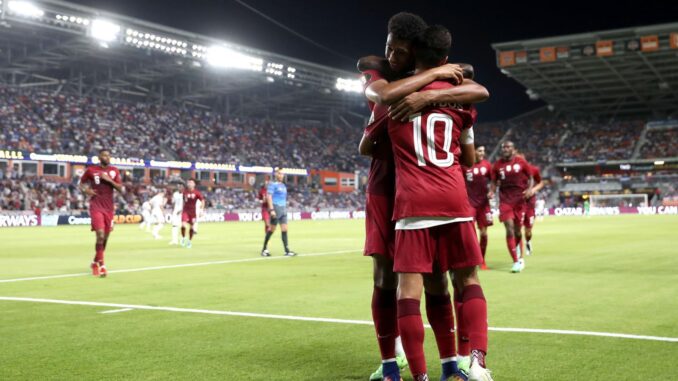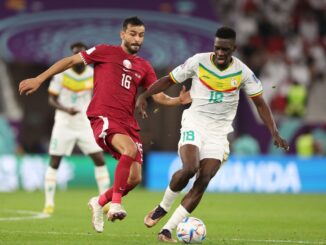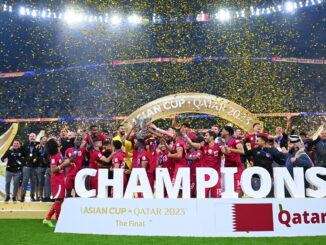
The latest episode in Qatar’s globe-trotting preparations for the 2022 FIFA World Cup saw the Maroons continue to punch above their weight as fans in North and Central America were introduced to Felix Sanchez’s multi-cultural, talented yet often controversial band over three weeks of CONCACAF Gold Cup action that culminated with the USA picking up their seventh title and Qatar reaching the competition’s final four.
With just over 15 months left until the opening match at the tent-shaped Al Bayt Stadium, Qatar have already tested themselves against opponents of various levels across four continents, competing at the 2020 Copa America, the European qualifiers and now the 2021 Gold Cup. All after having lifted the 2019 AFC Asian Cup trophy in Abu Dhabi.
Over in Texas, it was a case of the good, the bad and the ugly as a cautious opening 45 minutes of the campaign gave way to a chaotic second period in which Qatar took the lead three times only to be clawed back by Panama every single time.
Almoez Ali delivered his best Dr Jekyll and Mr Hyde impression missing two sitters in the first half before opening his account just after the restart to become the first-ever player to score in three different continental competitions.
Akram Afif made a lasting first impression in the region and there was a cheeky Hassan Al Haydos Panenka to squash any doubts around the Qataris being able to compete.
But for every inch-perfect long pass from Bassam Al Rawi there was a moment of erratic positioning by Abdelkarim Hassan and for every spell of dominance dictated by a Sergio Busquet-esque display from Karim Boudiaf there was a moment of panic as the young Meshal Barsham faced a shot or a cross.
Four days later it was less of a challenge as Qatar stormed to a 4-0 triumph over a Grenada side ranked a hundred places below them. A different level of opponent, a different scoreline, but some of the same themes emerged again.
Ali’s movement putting him in scoring positions, him squandering chances then finding the back of the net. Hassan offering solutions but also posing questions in his adopted left centre back position and Afif once more being the creative heart of the team.
Perhaps the moment when Qatar truly presented their credentials was in crunch time in the group as they took on Honduras, the highest ranked of the three Group D opponents and the group leaders going into the final matchday.
With Panama facing lowly Grenada late in the night, Qatar knew a result was needed to secure passage to the next stage and Sanchez’s men duly delivered. A missed Afif penalty notwithstanding, it was a perfect performance from the Maroons as young left-back Homam Al Amin broke his international duck in style and stand-in captain Abdulaziz Hatem sealed the win late on.
His slow starts to every game behind, Ali needed just 95 seconds to put the ball in the back of the net as Qatar took on El Salvador in the quarter-final. By the time the clock showed seven minutes, Hatem had sent in a trademark strike into the net, albeit this time with his weaker right foot. By the hour mark, Qatar were too far ahead to be caught as Ali converted from the spot for his fourth of the campaign, declaring himself top scorer in North and Central America, two and half years after he had reigned supreme in Asia.
A 3-0 walkover was perhaps too boring for the would-be World Cup hosts and they nearly shot themselves in the foot, giving away two easy goals to find themselves holding to a one-goal lead with 15 minutes to go. It took a heroic Barsham effort in added time to deny El Salvador an equaliser and secure the win and drive them into a historic semi-final clash with hosts the United States.
By the time the semi-final arrived, Qatar were playing without pressure, knowing they had already done their fans proud, but they dared to dream against the tournament’s record winners.
For a moment there when Al Haydos stepped up to take the penalty an hour into the game, it felt like the impossible was suddenly possible, but alas, it was not to be as the skipper overcooked his effort, trying an awkward combination of a start-stop run and a Panenka, eventually sending the ball over the crossbar.
When they goal finally came, five minutes from the final whistle it went the home side’s way. The jaded Qatari players could not cope with the high press and were left to rue their luck as Gyasi Zardes ended their run of three consecutive wins. With Al Haydos, Afif and Hatem all already subbed off, there was not much left in terms of creative energy on the pitch and the Americans walked away with the victory.
Far from a side in a rebuilding stage, the Gold Cup offered Sanchez the opportunity to further fine tune a side that will carry the dreams of the nation in less than 18 months, but despite the positive displays the Spanish coach will have left the United States with a few pieces of the puzzle still to be figured out.
One of the biggest changes this Qatar side has seen since the 2019 AFC Asian Cup was the rise of Barsham between the sticks. The 23-year-old rising from third choice at Al Sadd as rapidly as his older brother Mutaz did in winning High Jump Gold for Qatar at Tokyo 2020. Barsham might have dethroned Saad Al Sheeb at club and country, but questions remain over his consistency, with heroic performances often coupled with fatal mistakes.
Despite two clean sheets against Grenada and Honduras, Qatar do not seem to have settled on a back five nor have found a solid combination. Each of the three central defenders offers something different. Al Rawi excels in his long ball distribution and free-kick ability but is also an intelligent reader of opposition movement despite his relatively small stature, while Khokhi is an assuring presence at the heart of defence with a balance of aerial prowess, ball-playing ability and leadership.
Hassan, meanwhile, has a blend of power and pace and his surging runs into midfield, and even into the final third at times, make the difference in many an attacking scenarios. But the three put together seem to struggle to form a solid defensive block.
The absence of Tarek Salman was felt and despite the promising displays of Amin at left wingback, there remains a question mark around Hassan’s best position and whether he is reliable enough defensively as part of the back three.
In midfield, Sanchez seems settled on a Boudiaf-Hatem double pivot which seemed to have provided the right balance between protecting the back line and supporting attacks, with both players a threat from long range and Boudiaf’s passing ability complimented by Hatem’s energy as well as his recently proven leadership qualities as he took on the armband when Al Haydos was on the bench.
If there was any area of the pitch that Sanchez can say he has already figured out, it is in attack with Al Haydos’ flexibility allowing his boss to rotate between a narrow set up of Afif and Ali as centre-forwards with the number 10 just behind them, or a three-man attack line with Ali being flanked by Afif on the left and Al Haydos on the right.
In both cases, the only challenge seems to be figuring out how to get Ali firing on all fronts at all time as he did in the UAE 2019 as opposed to his erratic miss three, score one displays since then.
In conclusion, Qatar look good as they continue their preparation for the World Cup. With the FIFA Arab Cup still to come in December and more games in the European Qualifiers, very few sides in history would have had as comprehensive a preparation for hosting a major tournament.
And if any one is to be trusted to figure out the remaining parts of the puzzle, then in Sanchez, the man who led this side through every single age group, the Maroons have got their man.
Photo: Qatar Football Association




